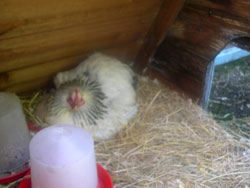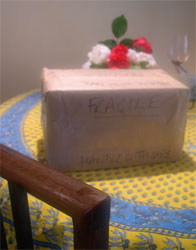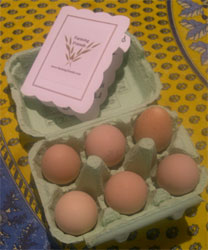How to breed any fowl using a broody hen: preparing a safe environment
Posted by Fiona Nevile in Chickens | 24 comments
Last weekend, Sara from Farming Friends generously offered us some Guinea Fowl eggs to put under our broody bantam hen, Mrs Boss. This would be an inter blog breeding event, a joint event hosted by Farming Friends and Cottage Smallholder.
We took up Sara’s offer. We would love Guinea Fowl in our garden. Why not give Mrs Boss a break? Having made up our minds we ventured into Sara’s Guinea Fowl gallery and were introduced to her regally named flock.
With the imminent arrival of guinea fowl eggs from the North, I left work early the next day to spring clean the family apartment aka The Ark. It has not been occupied since Thumper sat on a nest and hatched Carol. I gave the outside and inside a good scrub.
The Ark’s handkerchief garden was full of weeds. These were easily hoiked out whilst Inca growled and yapped from the other side of the wire.
Having removed the nettles (chickens hate these – perhaps they get stung like us?), Carol, our Maran hen, sauntered in and hoovered up the tasty weeds. She would not be chased away and stayed to supervise the preparation of the nest box, a woodchip base with a bouncy nest of fresh hay. There was a hole in the ark (I suspect rats) which I repaired with a tin can. Carol inspected the repair carefully and dissapeared for a dust bath.
I lifted Mrs Boss out of the main chicken house and introduced her to the vacant apartment. She was unimpressed until she spotted the large super king sized nest complete with decorative china egg. She leapt onto the bountiful nest with a cluck and settled immediately.
Meanwhile, in Yorkshire, Sara hunted for Guinea Fowl eggs. Her Guinea Fowl nests have been attacked by foraging Magpies so this was not an easy challenge. When she had finaly found six eggs, she packed them up and posted them.
I woke at six, instantly awake. The postman arrived four hours later. He was intrigued when I signed for the parcel. He couldn’t believe that it contained fresh eggs.

I carefully unpacked the box. Sara had clearly taken enormous trouble to pack them. Excitement lightly dusted with apprehension. All the eggs were fine. I nipped down the garden in nightdress and wellies with the box of precious eggs, with Inca in tow.
I removed the china egg from under Mrs Boss and gently placed each egg underneath her warm fluffy wing. The diminutive chicken accepted each one with a small cluck and shimmy, to settle the eggs in place. By the time I was putting the sixth egg in place, she gave me a quick beady-eyed look as if to say,
“That’s enough now.”
All fowl eggs are in suspended animation until they are incubated, either in an electric incubator or under a broody hen. The incubation temperature is 37º to 38º c. Prior to incubation eggs can be moved and even sent hundreds of miles in the post.
If you are going to go down the hen rather than egg incubator route you must have a broody hen. Just putting a few eggs in a nesting box and hoping that a hen will see the light and sit on them will not work.
 Once incubation begins the eggs cannot be left to get totally cold. The broody hen will occasionally move off the nest but will generally return within a few minutes.
Once incubation begins the eggs cannot be left to get totally cold. The broody hen will occasionally move off the nest but will generally return within a few minutes.
A broody hen flattens on the nest and seems to enter a trance-like state. Food and water need to be available close to the nest, a sort of all day breakfast in bed. Generally I boot a broody hen off the nest twice a day so she can stretch her legs and not foul the nest. She will nip back to the nest pretty quickly.
Booting a hen of the nest is probably unnecessary but it gives you the chance to check it and the eggs. Both need to be clean. Checking is impossible if the nest of eggs is covered by a broody hen.
In just under a week Mrs Boss has moved from the lowest in the pecking order of our flock of chickens to an international cyber chick superstar. When I photographed her this evening, she looked happier than she has for months. Hopefully she will be the adopted mother of a clutch of keets, in 28 days time.
If Mrs Boss could speak I am sure she would say,”Thank you, Sara.” From the bottom of her chicken heart.
Leave a reply





Hi Fiona, I realised my mistake over names as soon as I’d pressed the submit button! Anyway, I had a change of heart over the incubaator/broody hatching and put them all under the broody. I think on the whole they are better at it re the humidity side. I’m not in favour of fan incubators for the hatching process as when I’ve tried all three, still air, fan assisted and broody, for similar eggs at the same time I’ve found the still air to be far more sucessful. I feel the fan incubators dry out the membrane too much; the broody is next best and the still air best of all. This is only from a few hatchings and mostly with duck eggs. So we’ll see what happens with the guineas. Broody hen seems to be sitting pretty fast so far and sneaks out when I’m not looking to leave proof that she’s getting of the nest once a day. This is probably too long to post as a comment!
Hi Judy
Thanks for dropping by and leaving the link. I’ve just checked it out. Marvellous stuff and fantastic photography.
It’s a coincidence that Whitey and Mrs Boss have the same colouring. Thank goodness Mrs Boss doesn’t peck me, yet.
Hi Fiona,
I thought you might enjoy reading about some other “foster” chicks hatching on another website
http://foodiefarmgirl.blogspot.com
Judy
Hello Virginia,
I would be fascinated to read the difference between incubating and broody chicken rearing of your Guinea Fowl eggs. Especially when they all hatch. Please let us know, it would add a lot to our inter blog breeding event.
Do you plan to pop the incubated eggs under the broody hen just before they hatch or are you going to teach your incubated keets how to fend for themselves?
Thanks so much for leaving a comment. Sara hosts the Farming Friends site – http://www.farmingfriends.com
I’m called Fiona.
Hi Sara, coincidence? I’ve just found your web page whilst looking for notes on incubating and hatching Guineas. I’ve had some through the post and put some in an incubator and some under a broody hen. They will be 3 days behind yours so great fun following your diary! Please keep going and good luck.
Hi Frankie,
I’m sucked in by this story too. I do hope that some of the eggs are fertilised and hatch out. Until now it has been a problem when Mrs. Boss has gone broody. Now it is a boon.
Suddenly I have twigged that a broody chicken can be useful.
Thanks for dropping by.
Hi Sara,
As Mrs Boss was happy to sit on china eggs, i didn’t think that your eggs would be a problem. But as you know, chickens are extraordinary creatures.
Hi Michelle
We are excited too. This is fun and hopefully, if all goes well, informative. We’ve passed the first three hurdles. Sara™s suggestion, the eggs surviving the trip in the post and Mrs Boss accepting the clutch.
Thanks for your comment, much appreciated.
I am so pleased that they arrived safely and Mrs Boss has taken to them. Farming Friends will be visiting regularly for up dates. I am so excited and thrilled that it is all going well so far.
Sara from farmingfriends
I’ve been completely sucked in by this story! Looking forward to updates on Mrs Boss’ progress.
Yes, I will give regular updates.
Mrs Boss should believe that the keets are her own chicks, if all goes well.
I hope you will be giving us regular updates on NestWatch!
If all goes well, how will Mrs Boss react to her adoptive brood?